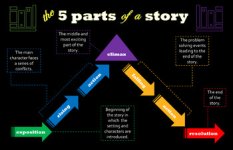StillStunned
Writing...
- Joined
- Jun 4, 2023
- Posts
- 3,879
In roleplaying games, there's a technique for designing adventures, or even campaigns: the 5-room dungeon.
Essentially, it breaks the plot down into five units: Guardian, Puzzle, Misdirection, Climax, Reward. In its most simple form, you might have a cave guarded by a pack of dogs. Inside is a puzzle or roleplaying challenge, which is about skills, for example a trap or a doorkeeper. Beyond that comes a red herring, or a fork in the tunnel. Then comes the boss fight, and after that the treasure and/or a plot hook.
It's very versatile, and it can be applied to dungeons, urban settings, social challenges, detective games or whole campaigns. The separate rooms can in fact also be broken down into smaller 5-room dungeons.
As I'm starting to plot a new story for my sword & sorcery characters Avilia and Sligh, I'm wondering whether the same setup could be used for writing fiction. Has anyone tried it before? What were the difficulties? Were there any design elements that needed changing compared with a roleplaying game?
Essentially, it breaks the plot down into five units: Guardian, Puzzle, Misdirection, Climax, Reward. In its most simple form, you might have a cave guarded by a pack of dogs. Inside is a puzzle or roleplaying challenge, which is about skills, for example a trap or a doorkeeper. Beyond that comes a red herring, or a fork in the tunnel. Then comes the boss fight, and after that the treasure and/or a plot hook.
It's very versatile, and it can be applied to dungeons, urban settings, social challenges, detective games or whole campaigns. The separate rooms can in fact also be broken down into smaller 5-room dungeons.
As I'm starting to plot a new story for my sword & sorcery characters Avilia and Sligh, I'm wondering whether the same setup could be used for writing fiction. Has anyone tried it before? What were the difficulties? Were there any design elements that needed changing compared with a roleplaying game?







